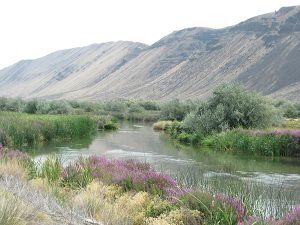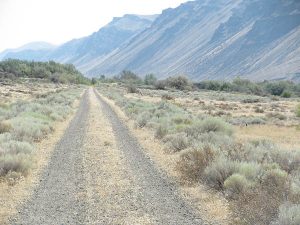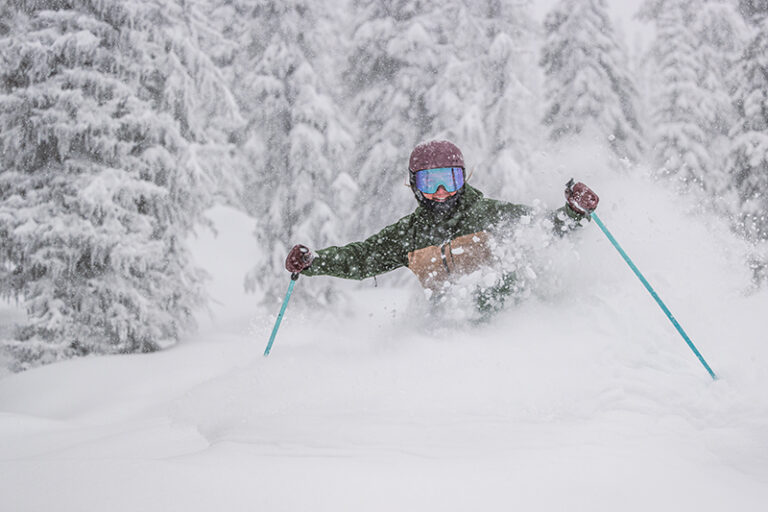Last August I spent five days riding my bike on the John Wayne Pioneer Trail and Columbia Plateau Trails from North Bend to Spokane. The dry eastern portion was the most interesting to me. It was the most challenging due to the heat and lack of shade but the most rewarding for the awesome silence and wide-open vistas.
The trail is a fantastic way to see parts of our state that we rarely get to see. Some may call deserts barren wastelands, but if you look closely, you’ll find that all deserts are full of life. Traveling at a bike pace of 10 miles per hour makes it easier to look closely than traveling in a speeding car does. I observed hawks, owls, coyotes, hummingbirds, numerous deer and even two bucks.
The sun-blasted desert landscape is a mix of cropland and scabland used for cattle grazing. The landscape itself changes in subtle ways. East of the Columbia River, the lush Crab Creek is a wonder to behold, even in the hot summer months. The wide, slow-moving creek feeds stands of feathery grasses and wildflowers, and it is a habitat for migrating birds, ducks and herons. To the south, the dramatic Saddle Mountain escarpment rises up like a dragon draped in sand.
The John Wayne Trail is a great way to see some of the rural farming communities scattered throughout central Washington. I rode through hamlets like Smyrna and bigger towns like Othello, Warden, and Lind. Smyrna was busy baling hay, and just outside Othello, I yielded to a convoy of giant combines driving down Highway 26. They honked their horns and waved to me.
After riding in silence on the trail and back roads all day, the noisy, busy highway shocked my senses. Away from highways, there is nothing but wind and light and the crunch of gravel under the tires. I tried not to rush, wanting to appreciate this landscape I so rarely bother to notice. I stopped often to jot notes and take photos.
Yet even on a bike it is possible to get in a rush, and still I rode past places I wished I would’ve stopped and looked more closely at. So on Crab Creek Road (the railroad ties are still present on this section, so you cannot ride the trail) near the end of the escarpment, I got off and walked the bike just to feel the solid ground and take in the haunting stretch on foot. I was exhausted and I’d found that pushing the heavy bike up even the slightest hill effectively conserved my energy when I still had hours left to ride.
With nothing else to do, I rode all day long, usually putting in more than 10 hours per day, riding 60-80 miles a day. I didn’t want to race back home, as I didn’t have anything pressing to get to back to, but it was exceptionally hot out – over 100 degrees. I had been worried about smoke from the record wildfires, but the wind had shifted, and Central Washington was clear of smoke that week.

On the evening of day four, I reached the fabled crossroads, the ghostly intersection of the two former railroads (the Spokane-Portland-Seattle Railroad and the Milwaukee Road). As far as I could tell by the weak signal on Google Maps, I was about 60 miles south of Cheney and half a day’s ride from the town of Lamont. The Columbia Plateau Trail crosses over the John Wayne; the former Milwaukee Road continues all the way to Tekoa on the Idaho border. But here I would hang a left on the CPT and follow the trail north directly to Spokane.
I unloaded the panniers and carefully picked my way up the steep embankment to the overpass. Looking up the trail, I discovered with dismay what looked like miles of the dreaded rail ballast. But this was why I rented a fat bike. Dropping the bags on the rocky trail, I slid back down, hefted the bike on my shoulder, and made my way back up again. At the top I collapsed, breathing heavily and feeling dizzy. I had ridden nearly 14 continuous hours, having left Warden at 6:30 a.m.
I set up my tent on the knobby rock and fired up my camp stove out on the trestle. Nearly out of water, I hesitated before using up the last drops to cook up a celebratory feast of dehydrated Kathmandu curry. On the trail, anything tastes delicious, but the curry ranked as one of the best meals of my life.
The sun was setting a dusty orange and purple as I sat on the trestle, my feet dangling over the edge, the aromatic curry steaming in its foil pouch. I had accidently thrown out my only spoon back in Vantage, so I shoveled the curry into my mouth with a long chunk of ballast rock. Stretched out into the muddled light before me was the trail I had just ridden: the John Wayne Trail. I did it alone, with no support, and I had reached the intersection with the CPT faster than I anticipated, riding through the highest temperatures of the year and with near-constant knee pain. I chewed a mouthful of curry, swallowed, and sighed. As darkness descended over the channeled scablands, I was overwhelmed with an intense satisfaction that brought me to tears. Out there, no one except the coyotes howling in the distance could hear me, and I doubted they cared. Their howls echoed as the sunset faded to a star-pierced sky. A huge meteor sailed across the horizon leaving a wake of blue stardust. I was overwhelmed and humbled by such beauty and solitude.
The next morning I awoke at dawn and broke camp, nervous about the heat and the chunky ballast. Day five was to be the hottest so far: 106 degrees. I was out of water, and riding on the ballast would slow me down. I set out north on the Columbia Plateau Trail just as the sun was about to peek over the eastern horizon. The ballast was shifty, sliding around like plates under my fat tires. The big tires helped stabilize me but it was still slow going. In places the trail surface was nearly overrun with tall sunflower-like plants and tumbleweeds that the fat bike easily plowed over.
This landscape proved to be one of my favorites. Deep channels had been worn into the basalt leaving high plateaus and mesas. Below the raised rail grade were circular ponds rimmed with lush grasses where cattle lounged in the shady bottoms, though some of the ponds had dried up into sandy flats. This was the channeled scablands, and I imagined the ancient Missoula floods raging through here toward the ocean thousands of years ago.

By 10 a.m. I was parched. I kept my mouth closed as the hot air dried my throat. I sucked on a pebble, which seemed to help, but it made my mouth taste like dirt. Then I found a disposable bottle of water lying in the middle of the trail. I reached down and picked it up. Though the seal was open, it looked clear. I smelled it, then tasted it. Satisfied it wasn’t urine or poison, I sent it down the hatch. I figured it had fallen out of someone’s bag, a bit of littering I was eternally thankful for.
A couple hours later I pedaled deliriously into the town of Lamont, only to find I had stumbled upon a modern ghost town. It was deserted. The only store – a mechanic shop – was locked up tight. I pedaled up and down the few residential streets, looking for someone in their yard, but not a single soul appeared. I finally spotted a water pump at the memorably named Bug-Tassel Park behind the little cinder block grange hall. I lifted the handle up and cold water gushed out. I knelt under its stream and let it soak me, rinsing three days of salt, sweat and grit off, this being the first such relief I’d had since Vantage. I filled a bottle and drank half of it in one gulp and then topped off the rest. I drenched my straw sun hat and set it on my head, and then sat on some grass in the shade.
I leaned back and breathed deep. I pondered phoning a friend and getting a ride home. I had no desire to ride ballast in the baking 106-degree heat, and I felt all my energy and drive quickly fading. I had run out of aspirin the night before, and my knees were killing me with every turn of the pedals. There were no more stores until Cheney. Suddenly my phone rang. It was my friend Jonathan. I admitted I was nearly done in, and he encouraged me to soldier on, insisting I was only a few hours from Cheney. He offered to ride out on the CPT and ride back with me.
I knew I would regret it forever if I didn’t complete the journey under my own power. I had come so far, and it would be ridiculous to bail half a day from the finish line. I reminded myself it was a mental game. Jonathan said he’d bring me a sub sandwich, and that sealed the deal. I got back on the saddle, my clothes already almost dry, and set off for the trail, though I ended up riding alongside it on Swift Road, the aptly named jeep track, until the ballast ended near the Martin Road trailhead.
A little while later I saw the “Entering Spokane County” sign, and I noticed the first pine trees I’d seen in 200 miles. Then I saw a figure in the distance, shimmering like a mirage. It was Jonathan. He was the first person I’d seen in three and a half days. We shook hands and he laughed in disbelief. “You just rode from Seattle! That’s so awesome.” “Yeah!” I said, “and I’m freakin’ tired!” We rode on a while, Jonathan peppering me with questions until we reached Amber Lake. We veered off the trail and coasted down to the boat launch and sat down in the shade under a willow. He brought out the sandwich and handed me a blue Powerade, which I guzzled in one gulp. I ate slowly. I had lost 12 pounds in five days, I discovered later – the JWT diet. Then I waded in and swam down to the cold water at the bottom of Amber Lake, rising refreshed and renewed.
The John Wayne Trail will stay with me for the rest of my life – the silence, the wind, the clink of pebbles beneath my tires, and the slow spread of dawn lighting up a vast expanse of desert devoid of people, yet teeming with wildlife even in the heat of August. I didn’t for a moment miss the bustle of city life.
I encourage everyone to summon their true grit and give it a shot. And no matter what, keep pedaling.
Follow Nick on his blog at www.nickoleum.blogspot.com.













